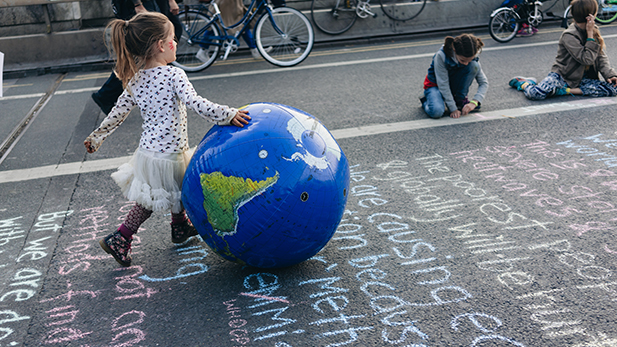Without deeper carbon emission reductions across all sectors, the 1.5°C goal is beyond reach, states the IPCC report

Photo: Shutterstock
The report highlighted that to limit warming to 1.5°C, we need global greenhouse gas emissions to peak and start declining from 2025 and be cut 43% by 2030. Current emission pledges are not ambitious enough to avoid surpassing 1.5°C increase in global average temperature. This warming increase will have certain consequential devastating impacts on human and natural environments across the world.
According to the IPCC, reaching net-zero carbon emissions by 2050 is necessary to stay under 1.5°C. This requires a rapid drop in emissions producing global warming from all aspects of society, from how we produce energy to how we consume it in our homes, travel, and industry, to how we plan and build the cities and towns we live in.
Associate Professor Maria Figueroa from the Department of Management, Society and Communication is one of the lead authors on this landmark report, focusing her work on the chapter that assessed global trends and societal drivers of greenhouse gas emissions.
As a lead author how did you contribute to the assessment?
The last three years I have been part of the IPCC Working Group III producing the third part of the Sixth Assessment report. This report looks at how nations and individuals can limit and prevent carbon emissions responsible for climate change. I was part of a group of 278 scientists from sixty-five countries. In my role as a Lead Author, I worked on a specific chapter and was also actively engaged in cross-chapter contributions and group work reviewing specific topical areas.
Within the chapter, I worked with other fourteen researchers looking at where our emissions come from, how they have changed over time and, looking into what societal drivers impact global greenhouse gas emissions trends.
We assessed the data and literature that serves to update the assessment of global mitigation policies and that allows to compare climate action progress and the impacts of national climate pledges in relation to long-term emissions goals.
The chapter also assessed the scientific literature looking into what socio-economic, technological, and behavioural patterns of production and consumption are driving the growth of carbon emissions globally, and what trends and emissions trajectories regions and countries have followed up to the present.
Describe the process of your involvement?
With every IPCC assessment cycle, countries nominate national research experts. Then, the IPCC Bureau makes the final selection in accordance with their required expertise needs and aiming at maintaining a regional and gender balance. I have been honoured to have been selected to work with IPCC already on previous reports and, therefore, I was happy to submit my application in response to the open call invitation from the Danish IPCC secretariat.
The IPCC follows a 5–7-year process cycle and the nomination of a country expert takes place at an early stage of this process. I encourage all researchers interested in participating to seek more information on how the IPCC selects its authors here.
What are the key messages coming out of this latest report?
The key messages from the IPCC Working Group III sixth assessment report are that greenhouse gas emissions causing global warming, are at their highest levels in human history (54% higher than in 1990); and that we are not on track to limit warming to 1.5°C.
At the same time, the report shows evidence of the effects of climate action. For example, it observes that the pace of the annual average carbon emissions growth has slowed down during the last decade, when compared with historical rates.
The report emphasizes that without deeper carbon emission reductions across all sectors, reaching temperature stabilisation at 1.5°C goal is beyond reach. Therefore, limiting the level of global warming as far as possible is the most important task.
We are already experiencing high level impacts from current warming. IPCC Working Group I on the science of climate change said that we should expect to see more frequent and more intense extremes – heatwaves and heavy rainfall – and that is what is happening. As temperatures increase, we expect hot and dry conditions to become more likely and fire weather conditions to become more frequent.
The IPCC Working Group III report demonstrates that there is an increase range of policies, laws and technologies that can lead to effective emissions reductions. It shows that improved technologies are decreasing in cost. In essence, this report emphasizes that actions to limit global warming that result in wider benefits to society can increase the pace, depth, and breadth of emissions reductions, and that accelerated and equitable climate action in mitigating, and adapting to, climate change impacts is critical to sustainable development. The report findings can be found here.
How does Denmark compare to others in its transition to a zero-carbon future?
The report does not list or compare individual countries. However, observing regional trends, the report shows evidence that a number of countries have been implementing targets and engaging in specific climate actions. Some of those countries have reduced CO2 and greenhouse gas emissions for more than ten years, and, in a few of these countries, their reduction rates have, in some years, being in line with rates that could likely limit warming to 2°C – as long as these rates are sustained. Furthermore, the evidence shows that these countries have concurrently been sustaining economic growth.
Denmark is among a group of countries that to date has achieved a level of emissions reductions that have been principally realised in the electricity and heat sectors, followed by industry and buildings. However, deeper, and faster emission reductions will be necessary as well, in transport and land use (agricultural sector), to keep the Paris agreement’s 1.5°C goal within reach.
